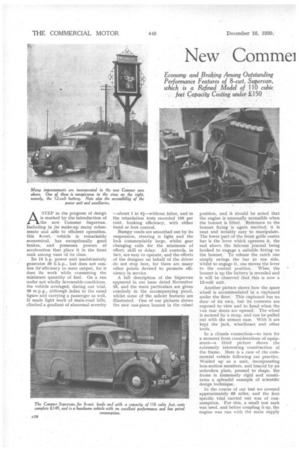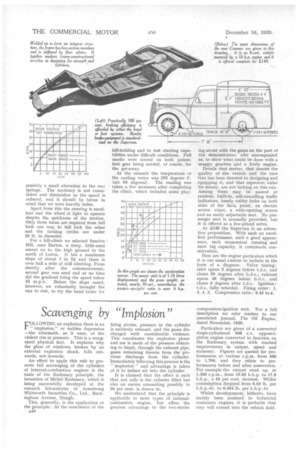New Cornmei hows Itself a Leader
Page 40

Page 41

Page 42

If you've noticed an error in this article please click here to report it so we can fix it.
in the light-van class
Road Test No. 292
ASTEP in the progress of design is marked by the introduction of the new Commer Supervan. Including in its make-up many refinements and aids to efficient operation, this 8-cwt. vehicle is remarkably economical, has exceptionally good brakes, and possesses powers of acceleration that place it in the front rank among vans of its class.
Its 10 h.p. power unit unobtrusively generates 30 b.h.p., but does not confine its -efficiency to mere output, for it does its work while consuming the minimum quantity of fuel. On a run under not wholly favourable conditions, the vehicle averaged, during our trial, 38 m.p.g., although laden to the rated figure and carrying a passenger as well. It made light work of main-road hills, climbed a gradient of abnormal severity
—about I in 5/—without falter, and in the retardation tests recorded 100 per cent, braking efficiency, with either hand or foot control.
Bumpy roads are smoothed out by its suspension, steering is light and the lock commendably large, whilst gear changing calls for the minimum of effort, skill or delay. All controls, in fact, are easy to operate, and the efforts of the designer on behalf of the driver -do not stop here, for there are many other points devised to promote efficiency in service.
A full description of the Supervan appeared in our issue dated November 25, and the main particulars are given concisely in the accompanying panel, whilst some of the salient features are illustrated. One of our pictures shows the new one-piece bonnet in the raised position, and it should be noted that the engine is unusually accessible when the bonnet is lifted. Reference to the bonnet fixing is again merited; it is neat and notably easy to manipulate. The lower part of the front grille centre bar is the lever which operates it, the end above the fulcrum journal being hooked to engage a suitable fitting 011 the bonnet. To release the catch one simply swings the bar to one side, whilst to engage it, one moves the lever
to the central position. When the • bonnet is up the battery is revealed and it will be observed that this is now a 12-volt unit.
Another picture shows how the spare wheel is accommodated in a cupboard under the floor. This cupboard has no door of its own, but its contentsare exposed to view and to hand when the van rear doors are opened. The wheel is secured by a strap, and can be pulled out with the utmost ease, With it are kept the jack, wheelbrace and other tools.
In a chassis connection—to turn for a moment from considerations of equipment—a third picture shows the extremely interesting construction of the frame. Here is a case of the commercial vehicle following car practice. Welded up as a unit, incorporating box-section members, and braced by an unbroken plate, pressed to shape, the frame is immensely rigid and constitutes a splendid example of scientific design technique.
In the course of our test we covered approximately 65 miles, and the first specific trial carried out was of consumption. For this, a small test tank was used, and before coupling it up, the engine was run with the main supply disconnected until the carburetter and petrol-lift pump, etc., were empty. Then a measured half-gallon was introduced and the vehicle driven until this was exhausted. The distance traversed was 20 miles. A second half-gallon took us 18 miles, making an average of 38 m.p.g..
This test was carried out on the Luton-Bedford road, which includes a number of moderately steep hills. For two of them third gear was required.
Next we investigated the brakes; the results are shown in an accompanying graph. It will be noted that there is little difference between the retardations afforded by the hand and foot systems. In this respect the Commer Supervan is almost unique.
Bendix equipment is used, and the lever operates on all four wheels. Moreover, it is very conveniently situated for a strong 'pull and affords an ample mechanical advantage. From 30 mph. the remarkable efficiency of
practically 100 per cent, was recorded —a stopping distance of 30 ft. by measurement.
The brakes take effect with great smoothness and do not influence the steering, whilst it is certainly worthy of mention that, although the road was wet, no skidding or sliding occurred. Credit for this is due to the non-skid surface as well as to the vehicle and tyres. Despite the smoothness of action, such was the retardation that care had to be exercised on account of the fact that the sand bags ballasting the van tended to slide forwards. Sand bags are usually a very stable load.
We were much impressed by this fea
ture of the vehicle's performance. It manifests the big strides that have been made in brake improvement of late.
Excellent, too, is the acceleration. Another graph gives the figures. Full advantage is taken of the powerful and high-revving engine by the choice of gear ratios, whilst the synchromesh gearbox minimizes time loss in changes.
It will be observed that the maximum in third gear (8 to 1) is 27 m.p.h. This gives an idea of the capabilities of the unit in respect of speed, as does the steepness of the curyes in respect of its quickness to attain high r.p.m.
Although the top-gear curve is shown only to 50 m.p.h., this is not the absolute maximum. We refrained from exceeding this speed, however, because of a slight but unmistakable tendency of the van to sway when the higher m.p.h. figures are reached. We suggest that perhaps an adjustment of weight distribution is called for or
possibly a small alteration to the rear springs. The tendency is not cumulative and diminishes as the speed is reduced, and it should be borne in mind that we were heavily laden.
Apart from this the steering is excellent and the wheel is light to operate despite the quickness of the motion. Only three turns are required from full lock one way to full lock the other and the turning circles are under 35 ft. in diameter.
For a hill-climb we selected Sundon Hill, near Barton, a steep, little-used ascent on to the high ground to the north of Luton. It has a maximum slope of about 1 in 5/ and there is over half a mile of stiff climbing. From shortly after the commencement, second gear was used and at no time did the gradient bring the speed below
15 m.p.h. Before the slope eased, however, we voluntarily brought the van to rest, to try the hand brake for
hill-holding and to test starting capabilities under difficult conditions. Full marks were scored on both points, first gear being needed, of course, for the get-away.
At the summit the temperature of the cooling water was 193 degrees F. (air 54 degrees). The reading was taken a few moments after completing the climb, which included some play ing about with the gears on the part of the demonstrator, who accompanied us, to show what could be done with a snappy gearbox and a lively engine.
Details that matter, that denote the quality of the vehicle and the care that has been devoted to designing and equipping it, and that represent value for money, are not lacking on this van. Among them may be named at random, built-in, self-cancelling traffic indicators, handy cubby holes on both sides of the facia panel, an electric screen wiper, a wide-opening screen and an easily adjustable seat. No passenger seat is normally provided, but it is offered as a low-priced extra.
At £149 the Supervan is an attractive proposition. With such an excellent performance, such a good appearance, such economical running and such big capacity, it commands consideration.
Here are the engine particulars which it is our usual custom to include in the form of a diagram. Valve timing: inlet opens 2 degrees before t.d.c. and closes 50 degrees after b.d.c.; exhaust opens 46 degrees before b.d.c. and closes 6 degrees after t.d.c. Ignition: t.d.c, fully retarded. Firing order: 1, 3, 4. 2. Compression ratio : 6.45 to.l.




































































